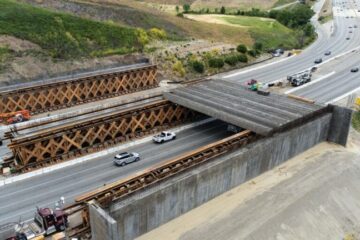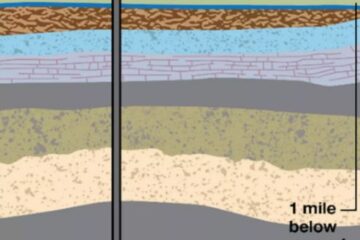Idaho Gov. Chosen for Interior
Dirk Kempthorne has urged changes to the Endangered Species Act, more state control of resources. He’s criticized by environmentalists.
Source of this article – Los Angeles Times, March 17, 2006.
By James Gerstenzang and Julie Cart, Times Staff Writers
WASHINGTON — President Bush said Thursday that he would nominate Gov. Dirk Kempthorne of Idaho to be secretary of the Interior, selecting a former senator — and fellow mountain-bike rider — to “ensure wise stewardship of our resources.”

CABINET SELECTION: President Bush and Gov. Dirk Kempthorne during a presidential visit to Idaho in August. One environmental activist called the Interior nominee divisive, but others offered termpered praise.
“Dirk will continue my administration’s efforts to conserve our land, water and air resources, reduce the maintenance backlog of our national parks, support historic and cultural sites … and develop the energy potential of federal lands and waters in environmentally sensitive ways,” the president said in an Oval Office appearance with Kempthorne at his side.
If confirmed by the Senate, Kempthorne, 54, will replace Gale A. Norton, who resigned last week after more than five years as Interior secretary.
Kempthorne, who is in his eighth year as governor, would bring Washington political and policy experience to the post. He served six years in the Senate, where he was deeply involved in debates over natural resources, and led the Environment and Public Works Committee’s subcommittee on drinking water, fisheries and wildlife.
As chairman of the Western Governors’ Assn., Kempthorne took the lead in calling for changes in the Endangered Species Act. Like many governors in the West, he has pushed for greater state control over management of endangered species and for greater payments to landowners facing losses brought by the law’s restrictions.
He also sued the Bush administration over a decision initially made by the Clinton administration to reintroduce grizzly bears into Idaho’s Bitterroot mountain range. The U.S. Fish and Wildlife Service proposal won support in the immediate region, but Kempthorne’s opposition led the Bush administration to withdraw the plan, according to statements from Interior Department officials at the time.
He fought the Clinton administration’s decision protecting federal wilderness from road builders — Idaho has 9.3 million acres of roadless forest — and helped resolve one of the largest water rights claims in the West, involving the Nez Perce Indian tribe, the state and the federal government.
His nomination drew quick and sharp criticism from environmentalists.
Carl Pope, executive director of the Sierra Club, said Kempthorne had “consistently opposed protecting public health and public lands.”
The League of Conservation Voters gave him a rating of 6 (on a zero-to-100 scale, with 100 at the top) in his first year in the Senate and a zero each subsequent year.
“As a senator and a governor, Dirk Kempthorne has been an unabashed champion of the resource extraction and development interests that profit most from public lands,” Philip E. Clapp, president of the National Environmental Trust, said in an e-mailed statement.
“The president could not have chosen a more divisive nominee.”
But others, particularly those who have worked with Kempthorne or tracked specific environmental issues in Idaho, offered tempered praise or said that his environmental philosophy reflected support for a limited federal role.
Bush met for about half an hour with Kempthorne at the White House on Thursday morning and offered him the job, White House Press Secretary Scott McClellan said.
Bush and Kempthorne served as governors at the same time, with the last two years of Bush’s tenure in Texas overlapping the start of Kempthorne’s in Idaho.
The president has in the past called on those he knew as governors for senior positions, and Kempthorne’s name was prominent in 2003 when the president was seeking a new administrator of the Environmental Protection Agency. Bush also spent time on vacation with Kempthorne in August, sharing a 16-mile bike ride on the trails of an Idaho mountain resort.
“Dirk understands that those who live closest to the land know how to manage it best,” Bush said Thursday. “And he will work closely with state and local leaders to ensure wise stewardship of our resources.”
In his remarks, Kempthorne set a goal of easing the disputes that roil about environmental issues — a particularly difficult mission in which sensitive policy and politics meet, firing great emotion and involving the potential of great fortunes to be won or lost.
As Interior secretary, his responsibilities would involve decisions on the use of vast stretches of open land, including some of the most stunning wilderness set atop needed energy resources; historic sites; and the Bureau of Indian Affairs.
He said Bush had assigned him, if he is confirmed, “to reach out to all constituent groups, to seek bipartisan support, to find common ground and to build consensus.”
“God bless America the beautiful,” Kempthorne said. “I would be honored to serve this land.”
A onetime mayor of Boise, Kempthorne has longevity in Idaho politics. He left the Senate after one term to run for governor, winning easily in 1998 with 68% of the vote.
He beat three primary challengers four years later and won the general election handily, but by a diminished margin, with 56% of the vote.
In contrast to the anger that national and regional environmental groups expressed about the nomination, individuals close to environmental issues in the region called attention Thursday to specific projects that Kempthorne had encouraged.
As mayor of the state capital, Kempthorne presided over creation of an expansive park stretching along the Boise River, known as the Boise greenbelt project.
In January, he introduced a $34-million program to improve state parks.
“Hopefully, he will carry that interest into Interior,” said Craig Obey, vice president for government affairs at the National Parks Conservation Assn.
Rick Johnson, executive director of the Idaho Conservation League, said Kempthorne’s support for states’ rights shaped his environmental philosophy.
“The ideology that he brings to the office has more to do with anti-federalism, bringing issues back down to a state level,” Johnson said. “He’s not a wing nut. Not an ideologue. He comes in wearing cowboy boots, but they are polished.”
More than 63% of Idaho’s land is under federal control, and many of the state’s largest industries rely on public land for timber and grazing.
Jeff Faulkner, president-elect of the Idaho Cattle Assn., said the governor had been a good partner for ranchers and was “really knowledgeable about what’s going on in the cattle industry.”
Kempthorne recently signed an agreement with the U.S. Fish and Wildlife Service giving the state control over gray wolves, which are being taken off the endangered species list. Cattle and sheep ranchers have generally favored the shift, which would allow the killing of wolves that attack livestock.
Gerstenzang reported from Washington and Cart from Los Angeles.


